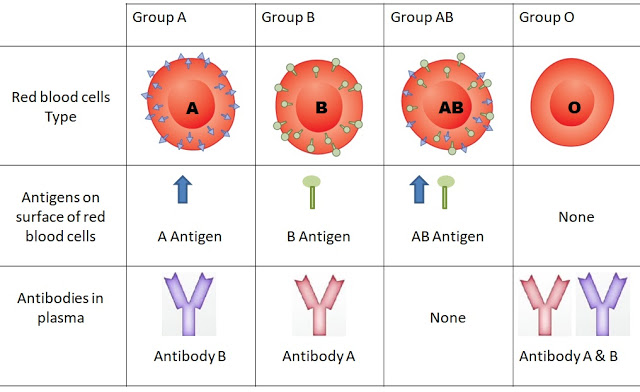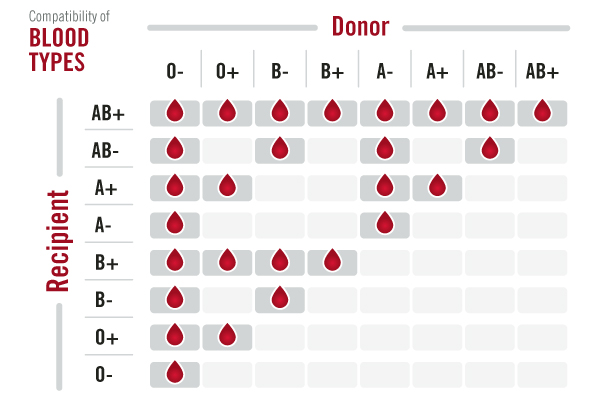Human Blood Types
Generally, there are 8 common blood types in the human race. They are A+, A-, B+. B-, AB+, AB-, O+, and O-. During blood transfusion, the blood types of the donor and the recipient are heavily checked upon to ensure that they are of compatible blood types. A mismatching blood type will trigger the immune system and turn the circulatory system of the recipient into a battlefield. What are the differences between the blood types and why are they important to know?
ABO and Rh Blood Groups

The 8 previously stated blood types are a combination of the ABO blood group and the Rh blood group. There are in total about 38 blood groups and not all have yet been discovered (more will appear from genetic mutation), but this combination of the ABO and Rh blood group are the most prominent.
The ABO blood group is decided from the antibodies that are present on the surface of the red blood cell. If the blood type is A, the blood has an A antigen on its surface. If the blood type is B, the blood has a B antigen on its surface. For AB both antigens are present, and for O, none are present. The interesting part about the ABO blood group is that, if the antigen is not present on the red blood cell, the antibody that counters that antigen is present in the plasma of the blood. The O blood type is recessive, while the blood types of A and B are codominant. When an O blood type is put together with A, the phenotype of that blood will be that of an A type blood, but the genotype of the blood will be AO. This is the same with an O with B type blood. If the two blood types put together are A and B, both properties will be present on the red blood cell, with the genotype of AB. For the inheritance of the ABO blood group system, you can think that you receive one from either of your parents. If the parents of a child have the blood genotype of AB and OO, the children could potentially have the blood types of AO and BO. If the parents have the blood genotype of AO and BO, the children could potentially have the blood types of AB, AO, BO, and OO.
The Rh (Rhesus) blood group is the second most important blood group following the ABO blood group and consists of 49 antigens. Among the 49 antigens D, C, c, E, e are the most important. The Rh blood types are determined by the presence of the D antigen and people who don’t have the D antigen are represented as – and those who have the antigen are represented as +.
This combined with the ABO blood type creates the 8 common blood types. Although these are the most important blood groups, there are currently a total of 39 confirmed blood groups with 1649 antigens.

Incompatibility of Blood Types
The incompatibility of blood types during transfusion are extremely dangerous and are potentially fatal. The immune system of the recipient views the new red blood cells as pathogens and works to destroy them. This process could cause fever and chills, blood in urine, breathing difficulties, chest, back and abdominal pain, muscle aches, blood clotting, nausea and many more. These symptoms will occur within a few minutes as it doesn’t take long for the blood to circulate the body. In order to prevent these incompatibilities, the blood of the donor and the recipient are cross-matched outside of the body and viewed for reactions.
The incompatibility of blood types not only happens during transfusion, but for pregnant women as well. If the baby has a mismatching Rh blood type with its mother, the mother’s body may have a sort of allergic reaction to the baby. This rejection of the baby could cause the baby to have anemia or serious brain damage: sometimes fatal. For such cases, the mother is given a Rh immune globulin injection, where Rh antibodies stick to the Rh positive red blood cells to prevent the mother’s body from reacting with the baby.
These different blood types were caused by genetic mutations that were meant to prevent certain diseases or to adapt to environmental pressures. Our ancestors all had type A blood and the rest are all genetic adaptations. For example, cells that are infected with malaria can’t stick to Type O and Type B red blood cells. People with type A are more prone to the dangerous effects of red blood cells clumping up in their blood vessels.
[1] Minesh Khatri. 2019. “What are Blood Types?”. Medicine Net. https://www.medicinenet.com/blood_types/article.htm. 2020/09/17.
[2] Dean L. Bethesda. 2005. “Blood Groups and Red Cell Antigens”. NCBI. https://www.ncbi.nlm.nih.gov/books/NBK2265/. 2020/09/17.
[3] Medi Molt. 2018. “Blood Group and Their Different Type ABO Blood Group Rhesus Blood Group Blood Transfusion Chart”. MEDIMOLT.
[4] “Facts About Blood and Blood Types”. American Red Cross. https://www.redcrossblood.org/donate-blood/blood-types.html. 2020/09/17.
[5] Donna Christiano, Deborah Weatherspoon. 2018. “What’s the Rarest Blood Type?”. healthline. https://www.healthline.com/health/rarest-blood-type#rarest-type. 2020/09/17.
[6] Kathryn Reyes. 2020. “Blood Types”. The Tech Interactive. https://genetics.thetech.org/ask-a-geneticist/how-many-blood-types-are-there”. 2020/09/17.
[7] ”Rare Blood Types”. Australian Academy of Science. https://www.science.org.au/curious/people-medicine/rare-blood-types. 2020/09/17.
[8] 2018. “Why are there different blood types?”. Washing State University. https://askdruniverse.wsu.edu/2017/08/28/different-blood-types/#:~:text=It%27s%20part%20of%20our%20DNA,%2C%E2%80%9D%20Fyfe%2DJohnson%20said. 2020/09/17.
[9] Maria Wilson. 2016. “World Blood Donor Day – 8 Facts About Blood Donation”. Dalhousie University. https://blogs.dal.ca/globalhealth/2016/06/01/world-blood-donor-day-8-facts-about-blood-donation/. 2020/09/17.
[10] 2020. “Rh blood group system”. Wikipedia. https://en.wikipedia.org/wiki/Rh_blood_group_system. 2020/09/17.
[11] “Blood Types”. hema-quebec. https://www.hema-quebec.qc.ca/sang/savoir-plus/groupes-sanguins.en.html. 2020/09/17.